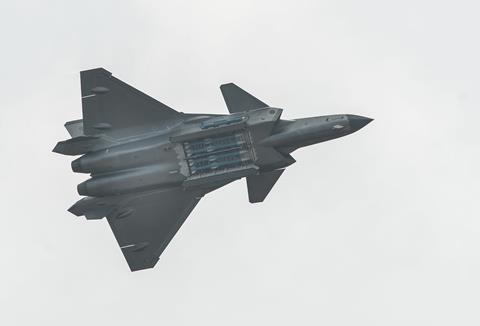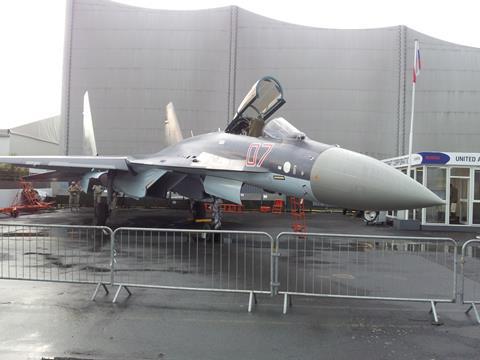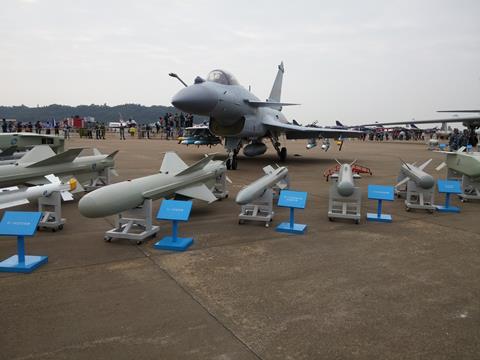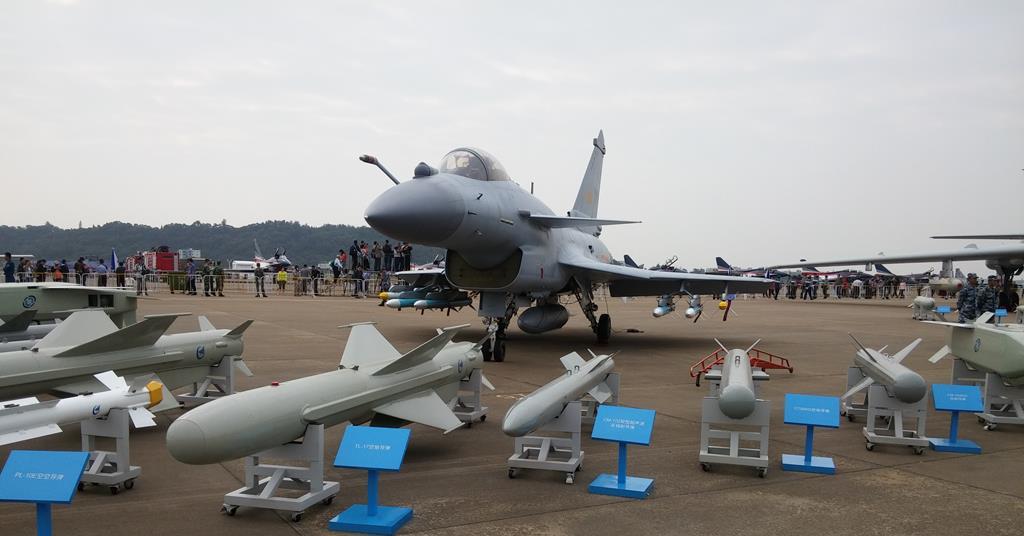The Royal United Services Institute (RUSI) has concluded that China is well on its way to eclipsing Russia in the field of combat aircraft.
In a recent report, the UK-based think tank contends that Russia and China are on different trajectories in combat aircraft development, with China taking a clear lead in areas such as sensors, datalinks, weapons, and low-observable technology. The single area where Russia retains an edge over China is in aircraft engines.

Source: Wikimedia Commons
The Chengdu J-20 can carry four PL-15 long-range air-to-air missiles in its main weapons bay, in addition to a pair of infrared-homing PL-10s in its side weapons bays
The report, authored by research fellow Justin Bronk, notes that the two countries largely rely on derivatives of the Sukhoi Su-27, that both have worked on low observable aircraft, and that both have increased multi-role capability.
Nonetheless, China is pulling ahead, with advanced types joining both the People’s Liberation Army Air Force (PLAAF) and People’s Liberation Army Navy Air Force (PLANAF).
“China has started to build a clear technical lead over Russia in most aspects of combat aircraft development,” says RUSI. “Moreover, Russian industry is unlikely to be able to regain areas of competitive advantage once lost, due to deep structural industrial and budgetary disadvantages compared to the Chinese sector.”
Among light fighters, RUSI contends that the Chengdu J-10 family is “significantly more efficient and flexible than the aging” RAC MiG-29/35 series. At the higher end, the Chengdu J-20 is the only deployed stealth fighter, apart from Lockheed Martin’s F-35 and F-22.
“The J-20 family will be produced in the hundreds over the coming decade, constituting the foremost existing aerial threat to Western air superiority types,” says RUSI.

Source: Greg Waldron/FlightGlobal
The Su-35 at the Paris air show in June 2013
Russia’s Su-57, on the other hand, has yet to become a frontline system, and lacks “the basic design features required for a true [low observable] signature”.
The report notes that Russia has struggled to field effective active electronically scanned array (AESA) radars, which offer pilots high detection ranges, but feature low probability of intercept/low probability of detection by adversaries.
As for China’s version of the Su-27, the Shenyang J-11, China has done a great deal to modernise the platform, including the use of composite materials that improve the Chinese version’s thrust-to-weight ratio. RUSI believes that the new J-11D version, equipped with an AESA radar, internal electronic warfare suite, and a superior weapons payload, will be superior to the most advanced iteration of the Su-27 family, the Su-35.
RUSI also regards the Chinese version of the Su-30, the J-16, as a major improvement.
“The J-16 features an AESA radar, increased use of composite materials for reduced weight, a fully digital ‘glass’ cockpit for both crew, compatibility with the full range of Chinese [precision-guided munitions] and a new targeting pod called YINGS-III which is roughly comparable to the US [Lockheed] Sniper pod,” says RUSI.

Source: Greg Waldron
The Chengdu J-10B at Airshow China in 2016
“Following its entry to service in 2015, the J-16 is expected to replace [China’s] Su-30MKK and MK2 fleets over the coming decade in both PLAAF and eventually PLANAF service, and is currently China’s most capable multirole and strike aircraft.”
The report speculates that the 2020s could even see Russia importing Chinese sensor and missile technology.
“For this to occur, the Russian government would have to overcome considerable levels of distrust between Russia and China in military terms, as well as deep-seated Russian pride and attachment to their sovereign aerospace industry,” says RUSI.
“However, the increasing superiority of Chinese radars, [air-to-air missiles] and targeting pods may prove sufficient motivation, especially in the face of a new generation of Western combat aircraft development programmes.”

 www.flightglobal.com
www.flightglobal.com
In a recent report, the UK-based think tank contends that Russia and China are on different trajectories in combat aircraft development, with China taking a clear lead in areas such as sensors, datalinks, weapons, and low-observable technology. The single area where Russia retains an edge over China is in aircraft engines.

Source: Wikimedia Commons
The Chengdu J-20 can carry four PL-15 long-range air-to-air missiles in its main weapons bay, in addition to a pair of infrared-homing PL-10s in its side weapons bays
The report, authored by research fellow Justin Bronk, notes that the two countries largely rely on derivatives of the Sukhoi Su-27, that both have worked on low observable aircraft, and that both have increased multi-role capability.
Nonetheless, China is pulling ahead, with advanced types joining both the People’s Liberation Army Air Force (PLAAF) and People’s Liberation Army Navy Air Force (PLANAF).
“China has started to build a clear technical lead over Russia in most aspects of combat aircraft development,” says RUSI. “Moreover, Russian industry is unlikely to be able to regain areas of competitive advantage once lost, due to deep structural industrial and budgetary disadvantages compared to the Chinese sector.”
Among light fighters, RUSI contends that the Chengdu J-10 family is “significantly more efficient and flexible than the aging” RAC MiG-29/35 series. At the higher end, the Chengdu J-20 is the only deployed stealth fighter, apart from Lockheed Martin’s F-35 and F-22.
“The J-20 family will be produced in the hundreds over the coming decade, constituting the foremost existing aerial threat to Western air superiority types,” says RUSI.

Source: Greg Waldron/FlightGlobal
The Su-35 at the Paris air show in June 2013
Russia’s Su-57, on the other hand, has yet to become a frontline system, and lacks “the basic design features required for a true [low observable] signature”.
The report notes that Russia has struggled to field effective active electronically scanned array (AESA) radars, which offer pilots high detection ranges, but feature low probability of intercept/low probability of detection by adversaries.
As for China’s version of the Su-27, the Shenyang J-11, China has done a great deal to modernise the platform, including the use of composite materials that improve the Chinese version’s thrust-to-weight ratio. RUSI believes that the new J-11D version, equipped with an AESA radar, internal electronic warfare suite, and a superior weapons payload, will be superior to the most advanced iteration of the Su-27 family, the Su-35.
RUSI also regards the Chinese version of the Su-30, the J-16, as a major improvement.
“The J-16 features an AESA radar, increased use of composite materials for reduced weight, a fully digital ‘glass’ cockpit for both crew, compatibility with the full range of Chinese [precision-guided munitions] and a new targeting pod called YINGS-III which is roughly comparable to the US [Lockheed] Sniper pod,” says RUSI.

Source: Greg Waldron
The Chengdu J-10B at Airshow China in 2016
“Following its entry to service in 2015, the J-16 is expected to replace [China’s] Su-30MKK and MK2 fleets over the coming decade in both PLAAF and eventually PLANAF service, and is currently China’s most capable multirole and strike aircraft.”
The report speculates that the 2020s could even see Russia importing Chinese sensor and missile technology.
“For this to occur, the Russian government would have to overcome considerable levels of distrust between Russia and China in military terms, as well as deep-seated Russian pride and attachment to their sovereign aerospace industry,” says RUSI.
“However, the increasing superiority of Chinese radars, [air-to-air missiles] and targeting pods may prove sufficient motivation, especially in the face of a new generation of Western combat aircraft development programmes.”

China surpassing Russia in airpower technology: RUSI
The Royal United Services Institute (RUSI) has concluded that China is well on its way to eclipsing Russia in the field of combat aircraft. In a recent report, the UK-based think tank contends that Russia and China are on different trajectories in combat aircraft development, with China taking a...









